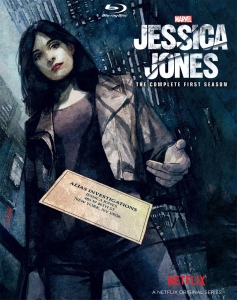Krysten Ritter – adorably quirky on “Veronica Mars,” “Gilmore Girls” and “Don’t Trust the B—- in Apt. 23” – shows the exact opposite side of her acting range in “Jessica Jones” Season 1 (2015, Netflix) as the titular self-loathing detective.
This season doesn’t venture too far from fellow Netflix Marvel Cinematic Universe show “Daredevil”: It’s in Hell’s Kitchen, and it’s about someone with a tragic childhood and superpowers trying to stop a powerful evil man.
Ritter goes grittier
It isn’t as good as the five-star “Daredevil.” A lot less money is spent on stunts and special effects. That having been said, creator Melissa Rosenberg and her team get maximum bang for their buck.

“Jessica Jones” Season 1 (2015)
Netflix, 13 episodes
Creator: Melissa Rosenberg
Stars: Krysten Ritter, Rachael Taylor, Eka Darville
They lean into the style – again, Hell’s Kitchen’s grit is evocatively lit by neon, and as you’d expect from a detective show, there are voiceovers and a jazz-loungey opening theme song.
But “Jessica Jones’ ” biggest strength is Ritter, who in her second leading role again plays a b—-, but this time a miserable one rather than a gleeful one.
The writers of this carefully (but sometimes too deliberately) crafted series make us understand why Jessica hates her own guts through two threads that play in parallel. In the main one, she must stop mind-controller Kilgrave (David Tennant).
In a thread that gets less screentime but that we care just as much about, we learn Jessica’s background. When she was a teen, her parents and brother were killed in a car accident while she was being distracting in the backseat.
And she killed a woman while under Kilgrave’s thrall; she logically knows this isn’t her fault, but she understandably feels guilt for shacking up with the widower, Luke Cage (Mike Colter), without telling him.
Kilgrave as metaphor
On the surface, Kilgrave is a less realistic villain than “Daredevil’s” corporate magnate Fisk. Kilgrave tells people what to do, and they do it; there isn’t a real-world equivalent. But metaphorically, there’s a lot to unpack about the notion of a mind-controller.
Consider victims of relationship abuse, in this time when a lot of news reports are coming out of Hollywood involving powerful men abusing women. Viewing these stories from a distance, we wonder why these women didn’t walk away from their voluntary relationship.
The answer is found in the psychology of the brain, and Kilgrave exaggerates that unfortunate but fascinating aspect of the human mind a thousand-fold.
“JJ” Season 1 can also be read as a treatise on paranoia. Jessica patrols a world where everyone is out to get her; all it takes is a word from Kilgrave. If one watches too much news about our scary world, such a feeling is perhaps inevitable.
Jessica’s ongoing fight against Kilgrave is arguably a fight to restore a measure of sanity, peace and goodwill to the society she lives in.

Here are my rankings of the 13 episodes from Season 1:
1. “AKA The Sandwich Saved Me” (episode 5, written Dana Baratta)
Baratta has written for quality TV shows dating back to “Dawson’s Creek,” so it’s no surprise she delivers this standout hour. In a delightful “take this job and shove it” scene that also shows her knack for digging up dirt, we see that Jessica can’t keep a cubicle job.
We get key story chunks about Trish (Rachael Taylor), Jessica’s foster sister and best friend, and neighbor Malcolm (Eka Darville), who isn’t the stereotypical druggie we assumed. The gritty fight scene outside the van is the series’ most competent bit of fisticuffs, and we get a nod to the comics in a flashback showing Jess rejecting Trish’s spandex costume prototype and suggested superhero name: Jewel.
2. “AKA You’re a Winner” (6, Edward Ricourt)
This hour is memorable for the climactic street-lit showdown when Jessica admits to Luke that she killed his wife while under the influence of Kilgrave. It’s a clear low point even for a hero whose default setting is “down in the dumps.”
Earlier, Luke admits he’s falling for this “hard-drinking, short-fused mess of a woman,” and that makes the conclusion sting even more, as the one positive new thing in Jessica’s life crumbles to dust.
3. “AKA It’s Called Whiskey” (3, Liz Friedman and Scott Reynolds)
“JJ” is often slow and brooding, but here we get a ton of important information in thrilling fashion. Maybe Jessica is right to hate herself: She uses her black, drug-addled neighbor Malcolm as a distraction while she steals drugs from the hospital.
The best part of the episode is when new lovers Jessica and Luke talk about how they got their powers: “Accident.” “Experiment.” It reminds me of “Buffy’s” dialog rhythms, specifically this exchange from Season 6’s “Smashed”: Buffy: “Hi. How’ve ya been?” Amy: “Rat. You?” Buffy: “Dead.”
4. “AKA Ladies Night” (1, Melissa Rosenberg)
The pilot made me think “OK, it’s like ‘Veronica Mars,’ but Jessica is more miserable.” Later, I’d realize this is not an anthology series, but initially this seems like a standalone case about a sweet Midwestern transplant named Hope, who has fallen under Kilgrave’s sway and who shockingly kills her parents in a memorable closing scene.
We soak up the show’s aesthetic, notably Jessica’s crappy apartment that also serves as her Alias Investigations office. Since she threw a client through it, the front door’s frosted window is missing, something that will become both an ongoing visual gag and the most iconic image of the season.
5. “AKA Smile” (13, Jamie King, Reynolds and Rosenberg)
While Season 1’s back half never reacquires the noir tastiness of the early episodes, the finale nicely wraps up the narrative with a shootout in a grand old bank building and a standoff at the docks. The way Jessica and Trish defeat Kilgrave pivots on a convenient new strategy where a code word releases Trish from Kilgrave’s sway.
Still, it’s nice to be done with Kilgrave (a great villain who overstayed his welcome) and move forward: The world thinks Jessica is a hero, and now she must decide if she’s willing to take up that mantle.
6. “AKA Take a Bloody Number” (12, Hilly Hicks Jr.)
On the heels of three water-treading eps, things ratchet up. After a reconciliation with Luke turns out to be too good to be true, our unlucky heroine fights the Kilgraved Luke in an empty night club.
I have a soft spot for this sequence because both the setting and the corner-cutting effects (for example, a close-up of Jessica’s feet “landing” after her jump from a balcony) remind me of “Buffy” Season 1, particularly “The Harvest.”
7. “AKA WWJD?” (8, Reynolds)
The concept is both creepy and nostalgic: Jessica returns to her suburban childhood home, restored to its old state by Kilgrave. We see how Kilgrave can control Jess by threatening others (a mind-controlled cook and maid), and the episode ends with an intriguing path-not-followed where Jess convinces Kilgrave to use his powers for good, at least once. Unfortunately, it’s obvious this path won’t be followed.
8. “AKA Top Shelf Perverts” (7, Jenna Reback and Micah Schraft)
The writers crib from “25th Hour” as Jessica enjoys a last day of freedom in New York City – including a stunning view from atop a bridge – before letting Kilgrave’s frame job work and turning herself in to the police, believing that’s the way to stop the villain’s killings.
Kilgrave confesses his love for Jessica, confirming hints from previous eps. As with “Buffy’s” Spike, we’re reminded that evil and the capacity for love are not mutually exclusive. Since Jess’ kind, socially awkward neighbor Ruben is Kilgrave’s latest kill, this is a good place to point out the show’s knack for personalizing victims.
9. “AKA Crush Syndrome” (2, Schraft)
A hardboiled staple – the sour relationship between P.I.s and cops – is established when Jessica says “The only thing you can charge me with is trying to make a goddamn living in this goddamn city.” Jessica goes undercover as a nurse in a hospital, something that jibes with her business’ name Alias Investigations, but unfortunately it’s a skill she won’t use the rest of the season.
Perhaps this is a deliberate choice to distance “JJ” from the Jennifer Garner series “Alias,” which premiered in 2001, two months before Jessica’s introduction in the unrelated comic book also called “Alias.” A blow against this episode is its first major action sequence, a bar fight where we see Luke Cage has invulnerable skin; it gets the message across, but it’s clear that stunts and action will not be a strength of this series.
10. “AKA 1,000 Cuts” (10, Baratta and Schraft)
Like “Take a Bloody Number,” this is another “everything is going great right before it all falls apart” episode, as Hope is about to be freed from prison and we know she’ll be killed by Kilgrave. That’s not exactly what happens, although she does end up dead. The killer twist, though, is that Simpson (Wil Traval), Trish’s ex-military boyfriend, turns out to be evil when he kills an ally cop in cold blood.
11. “AKA Sin Bin” (9, King and Baratta)
“Sin Bin” in structured like the “Angel” Season 4 episode “Soulless,” where Angelus is locked in a cage and using psychological tricks to try to get his captors to free him. It doesn’t work as well here because Kilgrave isn’t as outwardly scary as the vampire, and he has every incentive to not use his powers, since Jessica is trying to catch him in the act on video. The oddly tension-free hour is appropriately capped with the revelation that Jess is now immune to his powers anyway.
12. “AKA I’ve Got the Blues” (11, Reynolds and Friedman)
This hour seems out of place as Jess and Trish deal with Simpson, who is essentially Riley from “Buffy” Season 4 on steroids. Since Riley and Simpson are literally on government-distributed steroids, I guess I’m saying that this is a steroids story on steroids.
To its credit, the fight scene in Jessica’s apartment that finds her and Simpson being flung through walls is decent, and it leaves the place in a hilarious state of disrepair for the rest of the season. I’m not thrilled about the implication of Simpson being the Big Bad of Season 2; his arc is fine, but I’ve had enough of him.
13. “AKA 99 Friends” (4, Hicks Jr.)
This is the only episode with an A-plot that stands outside the serial structure, and while I long for more standalone episodes, the fact that it’s the only one hurts it. At the end of a convoluted plot, a woman aims to trap and kill Jessica because she has superpowers.
The woman lumps Jessica in with those responsible for “The Incident” from “The Avengers,” in which her mother was killed. I loathe collectivism, and our heroine rightly goes off on the woman for engaging in such intellectual laziness. But it’s almost out of character that the self-loathing Jessica bothers to stand up for herself.
How would you rank the 13 episodes of “Jessica Jones” Season 1? Share your lists in the comment thread.

